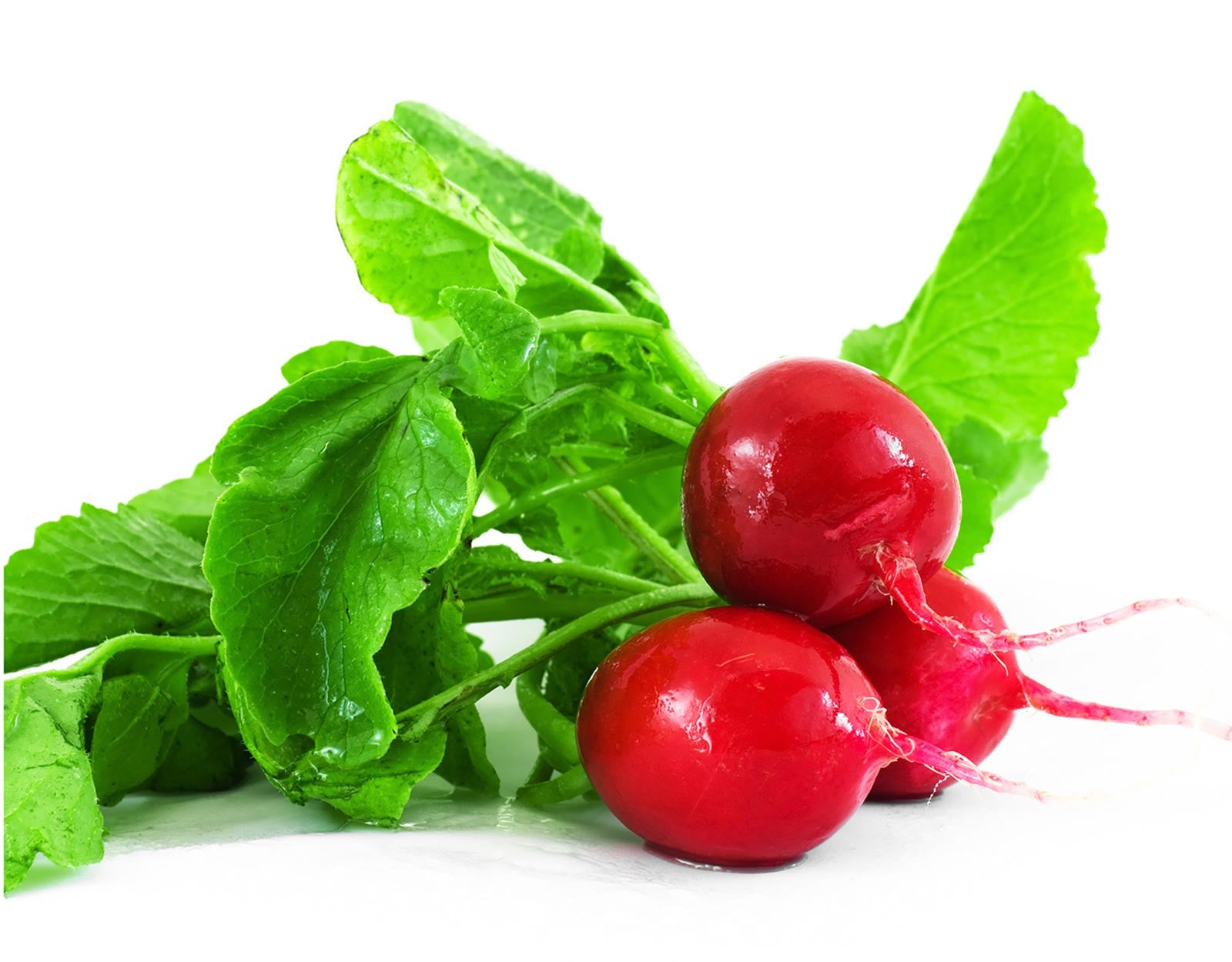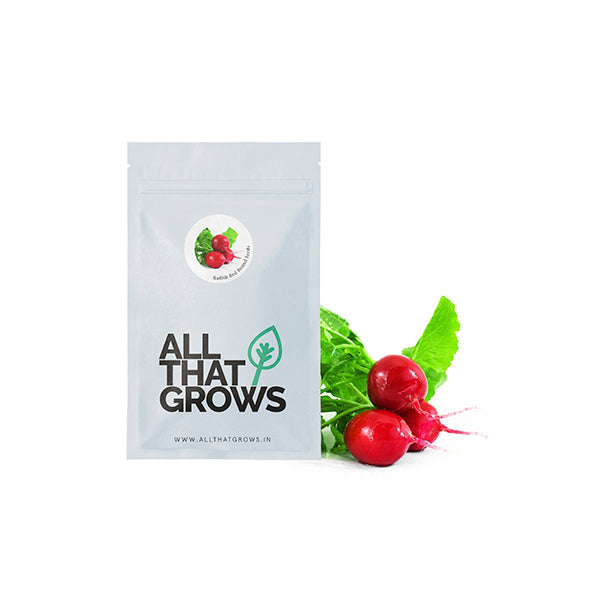



- SOWING
TIMEMay - Dec
- Sowing
DistanceLine to line - 12"
Plant to plant 2-3" - Fruit
WeightN/A
- Fruit
Shapelong and tapering
- Days to
maturityAfter 30-35 days.
- Details
- How to sow
- Reviews
The red round Radish is not as pungent or bitter as the white slender and tapering ones. They were grown mostly in mainland China and other parts of Southeast Asia in the pre-historic times dating back to the 3rd century. Radishes were also commonly found in Greek and Roman lands.
Radishes are a great crop to grow because of their sturdiness and pest-resisting strains. In fact, the Latinized name, of the genus, Raphanus, is a derivative of the Greek expression raphanos which means easily reared. They taste great and spike the flavor of any dish or salad with their unique spicy selves. Round radishes are extremely potent as nutrient-providers and supply a healthy dose of vitamins, minerals, and fiber to the system. If you are considering a detoxifying cleanse for your body then Radish can be the vegetable to rely on. From constipation to respiratory disorders, Radishes can prove extremely useful in a range of diseased conditions. Consumption of raw radishes everyday also results in well-nourished and glowing skin. Radish also improves the health of hair, dramatically. You can eat the Red round radishes raw, cooked, or steamed.
With so many health benefits and a taste that is only a tad bit lighter than the famous Wasabi, the red Radish must find its way to your kitchen gardens. Shop our pure ATG, non-GMO, and non-hybrid right away
Planting instructions
Plan a fall planting. Plant 4-6 weeks into fall before the start of the winter.
Directly sow seeds ½ to an inch deep and one inch apart in rows that are 12 inches apart.
Thin to about 2-inch spacings. Avoid crowding of plants together.
Radishes when planted in too much shade—or even where neighbouring vegetable plants shade them—they invest all their energy into producing bigger leaves.
Practise 3 year crop rotation.
Growing Requirements
watering
Radish seeds should be planted in moist soil during mid-autumn. Infrequent watering gives radishes a woody texture and a hot taste.
pests
The pests that attack radish can cause the roots to fail to form, tiny shot-holes in leaves of seedlings, leaves to turn dull yellow, curl, stunted - making them brittle and deformed. Common type of pests that affect this crop are Cabbage Root Maggot and Clubroot.
soil
Radishes prefer well-drained, loose soil, high in organic matter, free from stones, with pH 5.8 to 6.8.
spot
The crop yields best produce in full sun.
temperature
Ideal temperature for germination would be 12 to 29 degree C [55 F to 85 F].
how to harvest
Radishes are quick to harvest, as rapidly as three weeks after planting.
Do not leave them in the ground for long after they have reached maturity, their condition will deteriorate.
Trim the tops off short, wash the radishes and dry them thoroughly.
Store in refrigerator in plastic bags. Radish greens can be stored separately for up to three days.

Customer Reviews
The productiveness of any seed we sell is subject to your local climatic conditions*, the sowing method you adopt, and your commitment to the planting process. We give no warranty, expressed or implied, and are in no way responsible for the produce.
Please note that all our seasonal recommendations/ sowing information is as per the local climatic conditions. *For more information on the optimum conditions required for growing seeds in your region, please contact us at, hello@allthatgrows.in or Whatsapp us at, +91 8544865077
Questions & Answers
Have a Question?
Be the first to ask a question about this.




Radish Red Round Seeds
Seed Type : Non-Hybrid, Open Pollinated and Non-GMO
Sowing Time : Suitable for May to December sowing.
Root character : round in shape and red in colour with white flesh
Maturity : After 30-35 days from sowing.
Grow this with
The red round Radish is not as pungent or bitter as the white slender and tapering ones. They were grown mostly in mainland China and other parts of Southeast Asia in the pre-historic times dating back to the 3rd century. Radishes were also commonly found in Greek and Roman lands.
Radishes are a great crop to grow because of their sturdiness and pest-resisting strains. In fact, the Latinized name, of the genus, Raphanus, is a derivative of the Greek expression raphanos which means easily reared. They taste great and spike the flavor of any dish or salad with their unique spicy selves. Round radishes are extremely potent as nutrient-providers and supply a healthy dose of vitamins, minerals, and fiber to the system. If you are considering a detoxifying cleanse for your body then Radish can be the vegetable to rely on. From constipation to respiratory disorders, Radishes can prove extremely useful in a range of diseased conditions. Consumption of raw radishes everyday also results in well-nourished and glowing skin. Radish also improves the health of hair, dramatically. You can eat the Red round radishes raw, cooked, or steamed.
With so many health benefits and a taste that is only a tad bit lighter than the famous Wasabi, the red Radish must find its way to your kitchen gardens. Shop our pure ATG, non-GMO, and non-hybrid right away
Seed Type : Non-Hybrid, Open Pollinated and Non-GMO
Sowing Time : Suitable for May to December sowing.
Root character : round in shape and red in colour with white flesh
Maturity : After 30-35 days from sowing.
- SOWING
TIMEMay - Dec
- Sowing
DistanceLine to line - 12"
Plant to plant 2-3" - Fruit
WeightN/A
- Fruit
Shapelong and tapering
- Days to
maturityAfter 30-35 days.
Planting instructions
Plan a fall planting. Plant 4-6 weeks into fall before the start of the winter.
Directly sow seeds ½ to an inch deep and one inch apart in rows that are 12 inches apart.
Thin to about 2-inch spacings. Avoid crowding of plants together.
Radishes when planted in too much shade—or even where neighbouring vegetable plants shade them—they invest all their energy into producing bigger leaves.
Practise 3 year crop rotation.
Growing Requirements
watering
Radish seeds should be planted in moist soil during mid-autumn. Infrequent watering gives radishes a woody texture and a hot taste.
pests
The pests that attack radish can cause the roots to fail to form, tiny shot-holes in leaves of seedlings, leaves to turn dull yellow, curl, stunted - making them brittle and deformed. Common type of pests that affect this crop are Cabbage Root Maggot and Clubroot.
soil
Radishes prefer well-drained, loose soil, high in organic matter, free from stones, with pH 5.8 to 6.8.
spot
The crop yields best produce in full sun.
temperature
Ideal temperature for germination would be 12 to 29 degree C [55 F to 85 F].
how to harvest
Radishes are quick to harvest, as rapidly as three weeks after planting.
Do not leave them in the ground for long after they have reached maturity, their condition will deteriorate.
Trim the tops off short, wash the radishes and dry them thoroughly.
Store in refrigerator in plastic bags. Radish greens can be stored separately for up to three days.



 Sign In
Sign In








